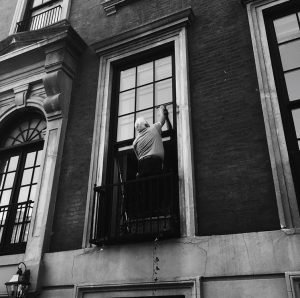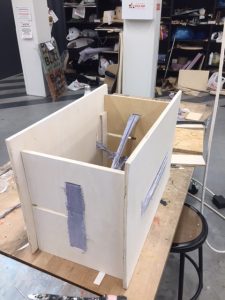The most apparent reason why South Koreans lean towards plastic surgery, especially surgeries that rejuvenate their appearance is because of the direct tie between ability and youth. Throughout my teen age, I had the chance to encounter a lot of different business men that worked for my father.
FINAL COPY:
The word “wrinkle” is defined as the following in the Oxford English Dictionary: “A sinuous or tortuous movement, a crease, fold, or ridge caused by the folding, a small crease of the skin, ripple on the surface of water.”[1] These multiple definitions of this word have one thing in common. They all are something resulting of an action and that happen over time. The movement of folding then leaving a mark, the years passing and leaving creases on the skin and the creation ripples on the surface of water in a moment. It is also apparent that the word “wrinkle” also has a tendency to easily portray images that coexist between object and human.
The works of the Argentinian artist Liliana Porter revolve around photography, paintings and prints of inanimate objects. One of her works titled: “Wrinkle”, is a photo etching piece made in 1968, which consists of ten series of photo etching images that show the progress of a paper getting wrinkled up, “aimed to address a discourse on materiality, artistic gesture, artistic meaning and visual landscape.” 2
Something to note are the two extra pages at the beginning. In front of the series of ten images, there’s a title page, and another page with a dialogue formatted interview with Emmett Williams, an American poet and visual artist who recently passed away in 2007.
The dialogue is a conversation between Emm and Ett. Later, we find out that it’s not an actual conversation between Emm and Ett, but it’s a play of words dissecting the name Emmett from Emmet Williams. This is where Liliana Porter’s intention and her play of “words” comes in place.
The conversation itself is very simple but has a strong stance on the topic of her work and art. The conversation revolves around art and relation with the word wrinkle with series of questions after questions. When one asks what still life of a dynamic process is, the other answers by asking a question on why they need art, then the topic transitions to how physical wrinkles on our face exists, and how destructive the act of wrinkling is. Towards the end of the dialogue, the conversation slowly ends when they start listing acts of wrinkling in everyday life like the “…earthquakes…”, “foot on my wrinkled white pants…”, and shoes the tie between art and the word “wrinkle” by referencing the work of Hokusai, a Japanese artist famous for depicting sights of eastern landscapes: “The image of ripples on water, Hokusai’s waves”3.
Liliana Porter’s works in general tie a close relationship with art and the audience with her series of inanimate objects as she explains “Many of these pieces depict a cast of characters that are inanimate objects…have a gaze that can be animated by the viewer, who, through it, can project the inclination to endow things with an interiority and identity”4 But specifically, with this piece of work titled “Wrinkle”, she stresses upon the relationship the word “wrinkle” has with the society and the human gaze and even suggests how they are “visual comments that speak of the human condition…”.5
And with that relationship of humans and the word “wrinkle”, it is no surprise that the first thing that comes into our minds is the condition of skin. Wrinkles are signs of aging, as the appearance of the skin starts to have visible creases usually around the eyes, mouth and chin, mostly delicate spots of the face. Skin aging in general is defined as the following:
“a complex biological process influenced by a combination of endogenous or intrinsic and exogenous or extrinsic factors.” 6
The different ways women start to take care of their appearance of their skin, to hide the natural signs of aging, grows. The anti-wrinkle creams and skin care product industry grows bigger and bigger as age acting upon skin is mostly what worries middle aged women the most.
Skin care routines are essential to most South Korean women. From a young age, I was exposed to having so many different types of skin care products that I had to apply in order. It was something I always waited for at the end of the day, as it felt like playing a game. My whole entire collection of skin care products would change if my skin would have a different problem, as I aged. My mother would never hesitate to buy better and more expensive products. She always used to say, “You can buy inexpensive clothes and accessories but money doesn’t matter for skin.”.
My brother in my family also was exposed to taking care of skin. He was the one who suggested that my mother and my father should take me to a dermatologist to take care of my acne when I was in middle school. He told my parents that in the society they live in right now, girls like me should start taking care of their skin since middle school and even scolded my parents for not taking care of it sooner. And soon I was introduced to this whole world of skin care, had appointments and had a whole collection of skin care routines. Normally skin care products come in different lines, separated into different age groups. Women aged in their 20’s, skin care products usually consist of products that help with acne or redness, and as the age level goes up, anti-wrinkle comes up more frequently.
This relationship between appearance of skin and how this certain culture builds upon this matter connects back to the coexistence of the world “wrinkle”. The first thing that would trigger an ordinary young South Korean woman in their 20’s, with the word “wrinkle” would be related to aging of the skin leading to cosmetic surgery. It’s because the age range of reproduction of skin is much slower and is hard to rely on just cosmetic products. Surprisingly nowadays, it’s not just the women, now men are equally sensitive to the word wrinkle as for them as “youth equals ability.”7
The most recent official statistics put the percentage of South Koreans undergoing cosmetic surgery in 2008, at around 20 percent.8 However, the actual number is likely to be considered higher as only a fraction of cosmetic surgeries is recorded and many of them get newly developed. The most apparent reason why South Koreans lean towards plastic surgery, especially surgeries that rejuvenate their appearance is because of the direct tie between ability and youth.
Throughout my teen age, I had the chance to encounter a lot of different business men that worked for my father. Everytime they’d come back from a break in Korea, they’d have small facial surgery done. Older businessmen would get Botox to smooth out their wrinkly skin, or remove the excess fat from the under eyes or chin. Made from a neuro toxin called botulinum toxin, it’s “predominantly used as a treatment to reduce the appearance of facial wrinkles and fine lines”. 9
The society’s pressure of having this idealism standards for beauty and its close relationship with success and ability has made the young people of South Korea, insecure and pushed them to rely on cosmetic surgeries. The negative connotation the word “wrinkling” has set upon the people in our society nowadays.
Referring back to Liliana’s Porter’s works that consist of expressing with inanimate objects that can be found in our daily lives, in this case the simple act of wrinkling a clean piece of paper indirectly imposes the “wrinkling” of the societal norms and insecurity of the people.
[1] Merriam-Webster, hacker Merriam-Webster.com, 2011
2Fosco Lucarelli. “Wrinkle – 10 Photoengraved Etchings by Liliana Porter With an…” SOCKS. April 23, 2016.
3 Liliana Porter, Wrinkle, Liliana Porter 2011
4 Porter, Wrinkle, Liliana Porter 2011
5 Porter, Wrinkle, Liliana Porter 2011
6 Ruta Ganceviciene, Liakou Aikaterini I., Theodoridis Athanasios, Makrantonaki Evgenia, and Zouboulis Christos C. “Skin anti-aging strategies” Dermato-endocrinology. (July 01, 2012)
7 Anna Fifield, “In South Korea, beauty is skin deep (just make sure to pierce the stubble).” Interview by Woohae Cho, The Washington Post. May 10, 2015, https://www.washingtonpost.com/world/asia_pacific/in-south-korea-beauty-is-skin-deep-just-make-sure-to-pierce-the-stubble/2015/05/10/4779f642-f354-11e4-bca5-21b51bbdf93e_story.html?utm_term=.1c77e3c56880
8 Ruth Holiday & Joanna. Elfving-Hwang, “Gender, Globalization and Aesthetic Surgery in South Korea” (2012):
9 Hannah Nicolas . “Botox: How Does Botox Work?” Medical News Today. August 15, 2017.
Shift:
Eric’s feedback and corrections definitely shifted my essay. The things I focused was the development of the argument I was trying to make. Of course there were other things like the basic formatting of the essay that I had to fix and re-organise, the descriptive annotated bibliography and so on.
Writing this essay was definitely a new discovery. I had never thought that creativity could be incorporated in writing an essay. The two examples of the braided essays that we read in class were truly fascinating as they were not only informative but also artistic and creative. And along the way of writing this essay, I learned some new techniques like using footnotes, making annotated bibliography, and basically truly got how Chicago formatting really functions.













